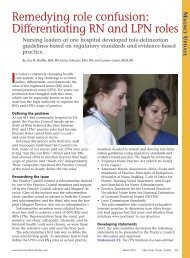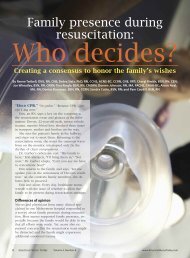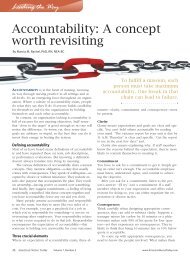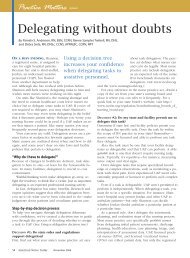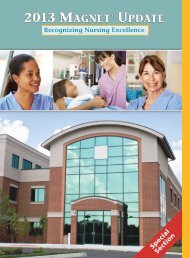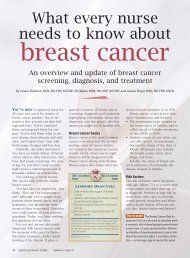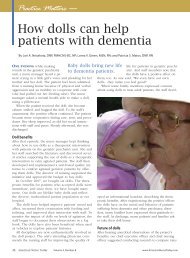2009 MAGNET™ PROFILES - American Nurse Today
2009 MAGNET™ PROFILES - American Nurse Today
2009 MAGNET™ PROFILES - American Nurse Today
You also want an ePaper? Increase the reach of your titles
YUMPU automatically turns print PDFs into web optimized ePapers that Google loves.
MAGNET <strong>PROFILES</strong><br />
Methodology<br />
Using an active learning strategy is<br />
one of the best ways to learn and<br />
retain knowledge. Initially, this<br />
strategy was developed to teach<br />
nursing students.<br />
As a model for this nursing research<br />
project, the NRC chose an<br />
active learning strategy described<br />
by Theil in 1987, in which learners<br />
participated in planning a mock<br />
study (including study design), the<br />
informed consent process, and the<br />
collection, analysis, and evaluation<br />
of data to compare two different<br />
chocolate-chip cookie recipes. After<br />
obtaining informed consent from<br />
mock study participants, the learners<br />
conducted a cookie taste test<br />
and elicited tasters’ opinions. From<br />
their data analysis, they drew conclusions<br />
about the tasters’ cookie<br />
preferences. This simulated research<br />
was an effective firsthand experience<br />
that helped nursing students<br />
learn the nursing research process.<br />
For its own nursing research, the<br />
NRC chose to adapt the Theil project,<br />
replacing chocolate-chip cookies with peanut<br />
butter. It wrote a study protocol and developed a<br />
study consent form and data collection tools. The<br />
protocol required NRC members to conduct a<br />
peanut-butter taste test, concealing the identity of<br />
two different peanut butter brands and offering<br />
samples to interested hospital staff. NRC members<br />
took the role of nurse researchers, coworkers served<br />
as study participants, and NRC mentors oversaw<br />
project development.<br />
To round out the nursing research process, the<br />
project was submitted for presentation to professional<br />
nursing audiences. It was selected by peer review<br />
as a podium presentation at two nursing conferences,<br />
one regional and the other national. As<br />
NRC members presented their research, they focused<br />
on the innovative style and advantages of the<br />
educational strategy.<br />
Teaching nurses about research: Key articles<br />
The Nursing Research Council at Robert Packer Hospital used the three articles<br />
below to help them devise a method for teaching staff nurses about nursing research.<br />
Author and citation Study purpose Findings<br />
Thiel CA. The cookie To describe a technique The experiment provided<br />
experiment: A creative for teaching the research a flexible approach for<br />
teaching strategy. <strong>Nurse</strong> process to undergraduate students to learn about the<br />
Educ. 1987;12(3):8-10. nursing students research process in a<br />
nonintimidating manner.<br />
Hudson-Barr D, Kenney S, To replicate the Great The project allowed staff to<br />
Watters C. Introducing the <strong>American</strong> Cookie participate in an exciting<br />
staff nurse to nursing Experiment for the experiment as a starting<br />
research through the purpose of educating point for research.<br />
great <strong>American</strong> cookie and engaging staff in<br />
experiment. J Nurs Adm. nursing research<br />
2002;32(9):440-443.<br />
Morrison-Beedy D, Cote- To develop an The project serves as a<br />
Arsenault D. The cookie “icebreaker” for an creative and effective<br />
experiment revisited: initial research class teaching strategy that can<br />
broadened dimensions for that provided be adapted at various<br />
teaching nursing research. exemplars throughout levels.<br />
<strong>Nurse</strong> Educ. 2000;25(6): the course.<br />
294-296.<br />
NRC members believe this hands-on approach<br />
made nursing research real to bedside nurses at<br />
Robert Packer Hospital. Firsthand experience with<br />
this process helped the nurses better understand<br />
published nursing research and their role in conducting<br />
such research or collecting research data for<br />
other nurses, and increased their appreciation of<br />
EBP in the clinical practice setting.<br />
By educating coworkers and sharing their work<br />
at the local and national levels, NRC members<br />
completed the nursing research process, illustrating<br />
the importance of disseminating nursing research<br />
outcomes to the larger nursing community.<br />
By the time of the hospital’s Magnet site<br />
survey, staff nurses were actively engaged in several<br />
EBP and nursing research activities and were<br />
able to show ANCC reviewers they were indeed<br />
Magnet-caliber nurses.<br />
■<br />
Plaudits for the “Peanutty” project<br />
Dubbed the “Peanutty over nursing research” project,<br />
this study generated much excitement and pride<br />
among NRC members. It enabled them to articulate<br />
the steps of the nursing research process and serve<br />
as unit resources to peers. Eager to share what<br />
they’d learned, they assembled posters that defined<br />
basic research terms and applied them to the study<br />
to illustrate the basic steps of the research process.<br />
They presented the posters at unit staff meetings<br />
and displayed them on nursing units.<br />
Selected references<br />
Visit www.<strong>American</strong><strong>Nurse</strong><strong>Today</strong>.com/Archives.aspx for a complete list<br />
of selected references.<br />
Sally Bennett and Mary Hicks are Clinical <strong>Nurse</strong> Educators and Debra Raupers is<br />
the Magnet Coordinator and Director of Nursing Education and Research at<br />
Robert Packer Hospital in Sayre, Pennsylvania. Lois Schoener is Director of the<br />
<strong>Nurse</strong> Education Program at Elmira College in Elmira, New York. The authors<br />
wish to acknowledge the members of the Nursing Research Council at Robert<br />
Packer Hospital, as well as Dr. Robert Bienkowski, PhD, Director of Research<br />
and Clinical Innovation at Guthrie Healthcare System, for their support and assistance<br />
with this project.<br />
60 <strong>American</strong> <strong>Nurse</strong> <strong>Today</strong> Volume 4, Number 8




